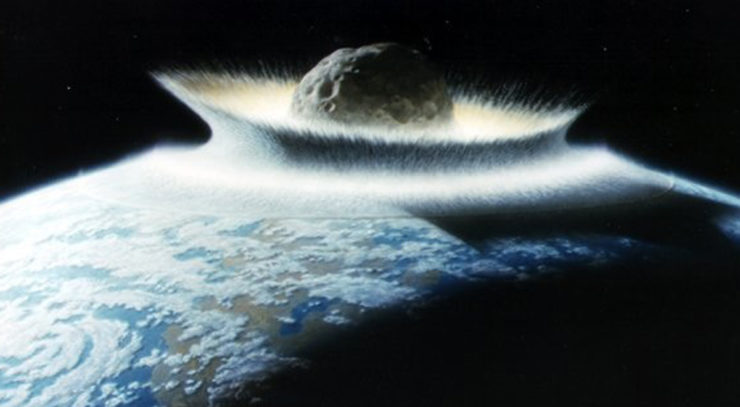Science marches on. One recent revelation: an educated guess as to when an asteroid hit in the Caribbean and created the Chicxulub crater: June. As you know, the violent impact (which occurred at pretty much the worst place that it could have occurred) is thought to have ended the Age of Dinosaurs.
Mass extinction by giant impactor is rare; more mass extinctions are correlated with (we can’t say for sure “caused by”) geological events such as the formation of large igneous provinces. Simple math suggests that the interval between Chicxulub-scale impacts is much, much longer than the likely lifespan of a species like ours. Perhaps we don’t need to worry. Too much.
Such impacts, while rare, are delightfully dramatic—just the sort of thing to appeal to authors. Thus, these five works featuring impacts from the sky, presented this June in honour of Chicxulub Day. (Whichever day that was, exactly.)
“Giant Meteor Impact” by J. E. Enever (Analog, March 1966)
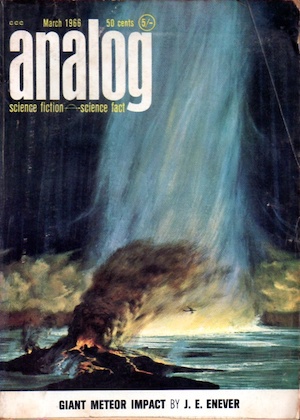
Enever tantalizes readers with a thrilling near-future impact scenario, but the story pasted over it is rather thin. This is because his fiction is mere parsley on a non-fiction article, one that explores the consequences of large impacts. Land and sea impacts are considered. Land strikes are bad. Ocean strikes are even worse.
Although hampered by the fact that research into this sort of event was far more rudimentary then than it is now (older research not aided by the fact that Enever was writing when computers were still at the banging-rocks-together stage and ARPANET hadn’t yet been invented), Enever carefully leads the reader through his simple model. The moral is clear: it would be better not to experience such an event.
Although it’s really not fiction as such, I include this article because it was for me and others of similarly antique vintage the first place that an impact scenario was discussed in detail. The article’s conclusions are vivid; it’s surprising that it didn’t inspire a flurry of impact stories back in the 1960s.
Rendezvous With Rama by Arthur C. Clarke (1973)
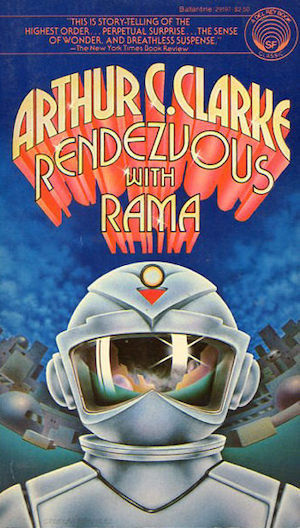
The novel begins with the unexpected arrival over Europe of a comparatively minor asteroid at 09.46 GMT on the morning of 11 September, 2077. It’s not a dinosaur-killer. Instead, this modest impact results only in the complete annihilation of Padua, Verona, and Venice, and the deaths of six hundred thousand people. Nevertheless, the calamity inspires a concerted effort to ensure there is no repeat.
The unintended consequence is that some decades later, an object traversing the Solar System—one that might otherwise have gone unnoticed—is spotted. Only a single crewed spacecraft is in position to rendezvous with the object, now named Rama. Rama is artificial, alien, and of considerable interest to humanity. Alas, orbital dynamics are a harsh mistress and its visitors won’t have long to explore the alien structure.
I suspect that Clarke opted for a comparatively modest impact for a couple of reasons. Firstly, being astronomically trained, he knew small impacts are far more frequent than large ones. Secondly, it might have been difficult to start the novel with a large impact without it becoming the center of the plot.
Thunderstrike! By Michael McCollum (1989)
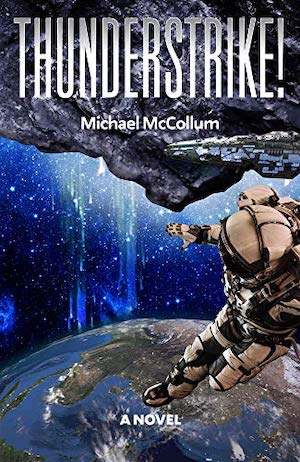
Astronomer Amber Hastings’ newly discovered comet contains a wealth of volatiles, sufficient to sustain the Lunar Republic for a long, long time. If someone can somehow claim and capture the comet, someone stands to make an fortune selling the volatiles.
The situation looks rather different from the POV of the Earth. Hasting’s comet is headed for Earth—if it collides with the planet, that could be the end of the world.
Is there any way to prevent the impact and capture the comet? There seem to be few resources already in space that could help.
As is my wont, I’ll kvetch about the worldbuilding here: The comet would be moving at an enormous speed. That would make it difficult to capture and mine. However, it’s not clear that, were it to hit the Earth, it would have the same devastating impact as an asteroid strike.
Despite its implausibility, comet mining turns up over and over in SF.
Moonfall by Jack McDevitt (1998)
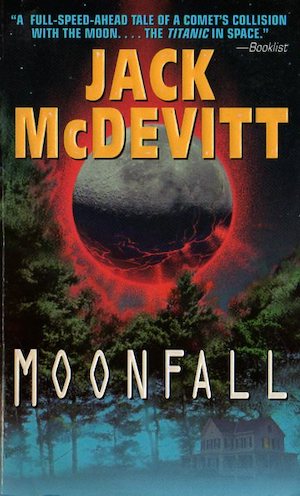
Astronomers appear to have had a historic stroke of luck, having spotted two noteworthy comets almost simultaneously. Closer examination reveals that the observations were of the same comet. The illusion that there were two was created by the interstellar visitor’s extreme speed. It covered a vast distance between the two observations. It’s just too bad that the visitor’s path terminates at the Moon.
Any relief Earth’s residents may feel that the primary effects of the impact will be felt on the comparatively unpopulated Moon is of little comfort to the people living on Moon, who now face death in less than a week. In any case, the impact will be energetic enough that the secondary effects could well end civilization on Earth, if not doom the species. With little time to act, it’s not clear if anything effective can be done.
The possibility that a Lunar impact could send significant debris in the direction of Earth has been used to argue against the intriguing possibility that 12th century monks saw the impact that created crater Giordano Bruno on the Moon. Such an impact should have been followed by meteor showers on Earth, which are not documented. Ah, well.
On the Edge of Gone by Corinne Duyvis (2016)
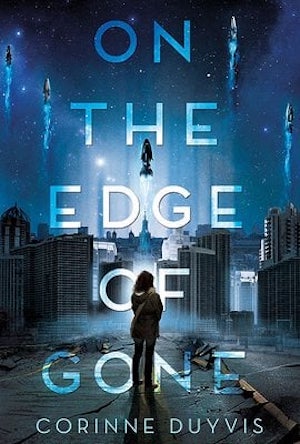
Faced with impending doom in the form of an inbound comet, humanity acted immediately, resolutely, and constructively. The very lucky and well-connected can try their luck on generation starships that will quest in search of Earth Two. The less lucky and more poorly connected can make do with shelters, which might not save them but might at least make the demise more protracted.
Autistic teen Denise and her mother were relegated to a shelter. Denise’ mother, who struggles with addiction, delayed leaving for the shelter until there wasn’t enough time to reach it. With the end of the world rapidly bearing down, Denise searches for some way, no matter how unlikely, to survive apocalypse.
I cannot go into detail because it is a huge spoiler for the end of the book, but this particular interstellar ark novel is one of very few of which I am aware that has a key insight into how to significantly shorten the search for a habitable planet following a terrestrial calamity. It’s one of the reasons I collect Duyvis novels.
***
There have been many novels/stories/films in which interplanetary objects have descended on Earth like some sort of Satanic impact-delivering tool. Perhaps I missed a favourite of yours. If so, feel free to mention it in comments below.
In the words of fanfiction author Musty181, four-time Hugo finalist, prolific book reviewer, and perennial Darwin Award nominee James Davis Nicoll “looks like a default mii with glasses.” His work has appeared in Interzone, Publishers Weekly and Romantic Times as well as on his own websites, James Nicoll Reviews (where he is assisted by editor Karen Lofstrom and web person Adrienne L. Travis) and the 2021, 2022, and 2023 Aurora Award finalist Young People Read Old SFF (where he is assisted by web person Adrienne L. Travis). His Patreon can be found here.










